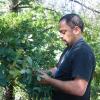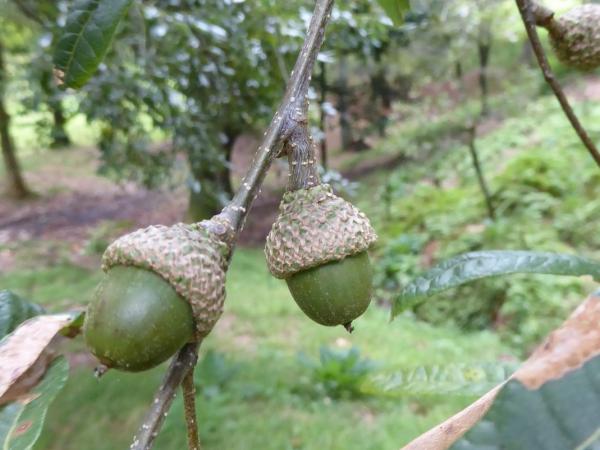Editor's Picks
Plant Focus
Oaks in San Luis Obispo County
Additional Notes on our Road Trip through San Luis Obispo County
I wrote the report of the second Post-Conference Tour, on this website a tour that took us from Cupertino to Los Angeles. Our editor had asked though to limit the number of words in these reports so the four Tour reports would be about the same length. Therefore I had quite some material that could not fit in the trip report, notes I took or recorded, information that I cross-checked. This blog post focuses on the day and a half we spent in San Luis Obispo County. The tree of that leg of our trip was clearly Quercus agrifolia from the champion Ancestor Tree at the Halter Ranch Winery to the pygmy trees of the Elfin Forest in Morro Bay. The Halter Ranch Winery is located near the city of Paso Robles. The locals pronounce Robles, the American way, "robels", and not the Spanish way. The name, our guide would tell us later, comes from Paso de los Robles, the early settlers confusing Quercus lobata, the valley oak, with the European oak, Quercus robur.
Halter Ranch Winery
The Halter Ranch Winery was bought in 2000 by Hansjörg Wyss, a Swiss entrepreneur, founder of Synthes USA, the US division of a Swiss-based medical device company, which was sold to J&J in 2012. Wyss is a renowned philanthropist and conservationist. He lives in Wyoming. He recently published an opinion in the New York Times announcing that he was donating $1 billion over the next decade to help "land and ocean conservation efforts around the world, with the goal of protecting 30 percent of the planet’s surface by 2030."
Our guide for the day was Dr. Matt Ritter, a professor in the Biology department at Cal Poly in San Luis Obispo and author of several books, one of which was published earlier this year, California Plants, A Guide to our Iconic Flora. The book is the third book Dr. Ritter wrote about plants of California. Not only did Professor Ritter give us a copy of his latest book, he also proved to be an outstanding pedagogue and most of what follows is a simple (but not comprehensive) transcription of his words. As an introduction, Matt told us a bit about the county that he seems to know inside out (he wrote a book about the Plants of San Luis Obispo). There are over 1,850 native species in San Luis Obispo County (aka SLO County locally), more than in the state of Alaska and many countries in the world. And the county is relatively small, less than 10,000 square kilometers, 1/3 of Belgium, and over 170 times smaller than Alaska. It is located in the center of the California floristic province, the Mediterranean western portion of California. Three quarters of the 21 oak species in California are found in SLO county and several were found on the ranch.
We were here to see a red oak, a specimen of Quercus agrifolia, the “world's largest known coast live oak." We therefore walked to this champion tree on top of a hill overlooking the vineyards. The tree can easily be seen in Google Maps.
One of the wines of the estate is named in honor of this tree. The tree had not been measured in four years. Matt Ritter uses a neat device to measure height and spread. The device has three high-powered lenses and it just uses focal length of the lenses to calculate distances. You can set it on any point and it will tell you the horizontal and vertical distance from where you're standing, with great accuracy. Our tree is 91 ft high (nearly 28 meters) and 105 ft (32 m) wide. We also measured its circumference: 27 ft (823 cm). These measurements are used to calculate a number of points based on the American Forests' points formula:
Trunk Circumference in inches
+ Height in feet
+ ¼ of the average crown spread in feet
= Total Points
For our tree that's 324 + 91 + 26 = 441 points

Quercus agrifolia is distributed along the Pacific Coast from northern Baja California in Mexico to Sonoma County. And although they grow into large trees in "many parts of their range, here on the Central Coast, they get particularly big because there is an interesting confluence of enough water and enough warmth in order for it to happen," said Matt Ritter. He added that interestingly the Spanish missions of California are right in the range of the coast live oak.

In the distance we could see Quercus douglasii on the slopes and Q. lobata at the valley bottom. There was probably a lowland forest of valley oaks there. We actually know very little about the original native range of Q. lobata because they were removed for agriculture and left as remnant trees either on property lines or in riparian areas. We do not know how many of them were here before the land was farmed.

We then climbed into the vans and drove to our next stop, Peachy Canyon. On walkie-talkies, Matt was pointing out plants along the road. We drove through a riparian forest of Q. agrifolia and Q. lobata, with an occasional Q. douglasii. Initially, a combination of olive and walnut orchards were planted here. Those have been mostly removed now and replaced with vineyards because "they take a higher price." The lichen we saw on old valley oaks left along the road is called lace lichen or spider lichen. Its scientific name is Ramalina menziesii. This lichen is the official California State Lichen, so designated in 2015 by Governor Jerry Brown. The old walnut here and there are Juglans regia (funnily called English Walnut), grafted on black walnut, J. hindsii and not J. nigra. Matt also noted that remnant stands of Q. agrifolia grow on north-facing slopes where they get a little more water than on south-facing slopes. Other plants Matt Ritter drew our attention to during that short drive were Toxicodendron diversilobum (nearly every Californian did during these IOS tours), Cornus sericea, and Fraxinus latifolia, just coming into fall color. Somewhere along the road there is also a hybrid oak, a cross of Q. lobata × berberidifolia. It has the size of Q. lobata with the leaves of Q. berberidifolia. This is the only such hybrid Matt Ritter has ever seen in the San Luis Obispo county.

Peachy Canyon Road
The name of the place comes from the peach orchards that were here before farmers switched to almonds, walnut, and later, vines. We came here mainly to see the relatively rare Quercus palmeri. But there are also great specimens of Quercus berberidifolia, one of the most common scrub oaks in California. To stand in the shade of a Q. berberidifolia is rather abnormal, said Matt. Like many white oaks, they are promiscuous. There might be some blue oak and maybe valley oak in those Q. berberidifolia (see also Sork et al., Phylogeny and Introgression of California Scrub White Oaks in International Oaks No. 27, the Journal of the IOS). There is also a huge diversity in shape and size of their acorns (more on this oak in the Flora of North America). The scrub oak was also was parasitized by mistletoe, a species called Phoradendron villosum, also found on Fraxinus. There were several interesting specimens of Q. berberidifolia around us. We had lunch in the shade of the tallest one.


Over lunch, Matt explained that the unprecedented drought that hit California in recent years killed a huge number of trees. Blue oak, Q. douglasii, was the hardest hit (200- to 300-year-old trees died). Q. berberidifolia was hit as well.
Climate change, that Matt calls Global Climate Chaos is one of the main threats to oaks in California. The other two threats are:
- Demography: everybody wants to live in coastal California causing more residential and commercial development; 40 million people live here and 40 more millions on the way.
- Agriculture: half of all the food eaten in the US is grown in California.
"All these vineyards around us were at one time oak woodlands. Just recently, a hundred acres of oak woodland were removed here in SLO County by a winery called Justin" to make room for more vineyards There were no laws preventing this in SLO county. An oak ordinance was proposed a decade ago but rejected by the agricultural community. Some counties do have oak ordinances." Santa Barbara county has a draconian one: you remove one oak that’s more than 4 inches in diameter, you have to replace it with ten oaks." (More on oak ordinances by two IOS members).
In the case of the site at Sleepy Farm Road owned by Justin Vineyards, cleared in 2016, county authorities issued a stop-work order and eventually passed an oak ordinance in April 2017. Lynda and Stewart Resnick, who own Justin through their company "Wonderful Company", apologized and decided to donate the land to a undetermined local conservation organization. To date, this has not happened, according to the San Luis Obispo Tribune.
After lunch, we walked down the road to look at Palmer oaks growing on the side of the road. Like Q. chrysolepis, Q. palmeri is an intermediate oak from section Protobalanus. The Flora of North America on www.efloras.org has a nice illustration of the oaks of that section.
Although Q. palmeri is a shrub oak and not a tree, specimens here were around 5 meters high. (In the excellent book Oaks of California, the authors say the tree is up to 10 feet tall, that's 3 meters). The tree is distributed in California, Arizona, and Baja California. It has a spotty distribution in California, Matt Ritter had told us earlier, with population often being clones. He cites as an example the 13,000-year-old single clone population in the Jurupa Mountains of Riverside County, described in a paper by Michael May et al., reported here on our website.

Then we boarded the vans again to follow Matt, who was driving his own car, walkie-talkie in hand, on for our last stop in the Los Padres National Forest. We drove to US Highway 101 and then up north. Along the highway, Matt again pointed out interesting plants or landscapes: populations of blue oak and valley oak growing side by side. Occasionally, we saw a pine tree and Q. agrifolia with them. Pinus sabiniana, gray pine or foothill pine, almost exactly matches the range of Q. douglasii. Blue and valley oak are the species most impacted by grazing. There are cattle in fenced land along the freeway. There are a few younger trees between the freeway and the fence, but none within the fenced area. We were headed for the Cuesta Ridge in the strangely-named Chorro Valley, Chorro being modern-day Mexican Spanish slang for diarrhea.
East Cuesta Ridge
From a turnout on the east side of Highway 101, we drove past a metal gate and up a forest road. Part of the area burned in 2015. Quercus agrifolia and Platanus racemosa generally survived the fire. We also saw a few willows, the most common willow around here, the arroyo willow, Salix lasiolepis. We drove up the East Cuesta Ridge. The East Cuesta is all Monterey shale rock formation. Looking down in the Chorro Valley, we could see 9 volcanic peaks, extending to the ocean in Morro Bay (from higher up, it is also possible to see Morro Rock). We could also see the fog bank coming into the bay, Pismo beach, and Point Conception. And down below (at our feet) was the city of San Luis Obispo. "This is all the Santa Lucia Range and the Cuesta Ridge is at the southern end of the Santa Lucia Range. We call the other side of the Chorro Valley, the Irish Hills." The dominant oak around us was Quercus agrifolia with an occasional Q. wislizeni. On serpentine, we could see Q. durata which tends to occur only on Serpentine. We also found small plants of Notholithocarpus densiflorus (Matt Ritter said SOD was absent of SLO county, probably because it is too hot and too dry).


Two interesting pine species also occur on the ridge: Pinus attenuata, a fire-following pine tree and the larger P. coulteri, a pine native to SW California and Baja California in Mexico. Walking along the dirt road, Matt drew our attention to several plants: Eriodictyon traskiae (an endemic shrub named after Blanche Trask, a botanist who in the 1800s studied plants on the Santa Barbara Channel Islands), and a series of typical chaparral shrubs: a legume, Pickeringia montana (chaparral pea), Arctostaphylos spp. (manzanitas), Ceanothus spp. and the "most common shrub in California chaparral, Adenostoma fasciculatum (chamise), a Rosaceae. One of the manzanitas seen was the rare Arctostaphylos luciana, a pretty plant, endemic to the Santa Lucia Range in SLO County, with nice red bark and blue sessile leaves. In his book, Dr. Ritter arranged plants by habitats and there is a whole chapter devoted to chaparral plants.

Morro Bay
The next day, we spent a few more hours in SLO county. We drove to Morro Bay that we could see from the East Cuesta Ridge the day before. Our destination was El Moro Elfin Forest, a 90-acre State Park in Los Osos. Rachel Davis explained briefly that the rainfall in Los Osos was less than 16 inches a year (that's 400 mm), that the park contained 200 plant species, 110 species of birds, 22 species of mammals, and 13 species of amphibians and reptiles. Just a day earlier, Matt Ritter had told us that the climax community on this old Pleistocene dune was an oak woodland of Quercus agrifolia and that at one point they had been designated as Quercus agrifolia var. frutescens because of their shrubby habit. However, one of his colleagues at Cal Poly, Robert Hoover had demonstrated that they were exactly the same species and that mostly edaphic factors determined their habit. Acorns we see on these trees would grow into tall trees in a different environment.

After our visit, we stopped for lunch at nearby Spooner's Cove. This beautiful beach is part of the Montaña de Oro State Park. After lunch we took off for Santa Barbara.
Photographs © Charles Snyers











